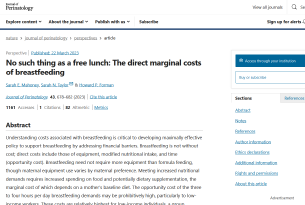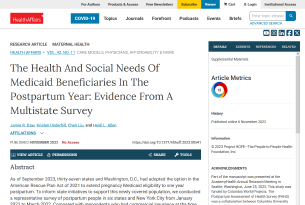Since 2019, the Prenatal-to-3 Policy Impact Center has empowered states with evidence on which policies positively impact very young children and their parents. Reviewing the evidence connecting state policies to outcomes for young children and their families is a key way we do this. And 2023 was a great year for research!
In today’s post, staff members share some of their favorite prenatal-to-3 research from 2023. On topics ranging from childhood poverty to health insurance coverage, the following studies helped advance the fields of child development and public policy.
1. Preventing Poverty After the Birth of a New Child

Alex Haralampoudis, PhD, Senior Policy Data Manager
A new baby is costly for families, who face increased medical expenses and necessity costs coupled with reduced income, especially absent any paid leave. In a recent Demography article, researchers from Columbia University’s Center on Poverty and Social Policy used monthly data on mothers in the 6 months before and after a birth to examine their household income relative to the Federal Poverty Level (FPL). Following a birth, the percentage of families experiencing poverty increases from 25 to 31 percent on average. Poverty rates are even more stark for new parents who identify as Black and Hispanic, who are particularly vulnerable to experiencing poverty post-birth. In fact, 40 percent of Black and Hispanic mothers experience poverty following a birth.
SNAP, WIC, and other policies play an important role in reducing the poverty rate. Existing government support, however, does not prevent mothers from experiencing poverty after a birth or reduce racial and ethnic disparities. When accounting for cash and near-cash government transfers, the poverty rate still rises from 18 to 24 percent after a birth. The researchers found that modifications to public assistance policies could ensure that, in the first months after welcoming a new child, mothers have sufficient income to fulfill basic needs.

Experiences of Poverty Around the Time of a Birth: A Research Note
2. The Myth of Breastfeeding as a Free Alternative to Formula

Kaeley Benson, PhD, Deputy Director
Early in my own maternity leave, some research on the marginal costs of breastfeeding resonated with me so deeply. In a recent Nature article, three Yale Medical School researchers emphasized that “breastfeeding is not a cost-free alternative to formula.” Their cost estimates of breastfeeding included equipment and nutrition supplements, as well as the opportunity costs (the greatest of which is time). Opportunity costs are often the greatest barriers to breastfeeding initiation and longevity.
Most importantly, the authors indicate how much more costly breastfeeding is for people who earn low wages and have limited flexibility in their jobs to pump. The authors’ final estimates of the total cost of breastfeeding (ranging between $8,600 and $11,600 in the first year) is nearly half the US FPL for a family of three.

No Such Thing as a Free Lunch: The Direct Marginal Costs of Breastfeeding
3. Quantifying Childhood Poverty in the Prenatal-to-3 Period

Natalie Skatter, Senior Policy Data Analyst
Many people know the Census Bureau for its decennial Census; however, the Census Bureau also surveys millions of households annually as part of the American Community Survey (ACS), which provides data that are crucial for our Center’s work. The ACS includes a measure of household income, which researchers compare to the FPL for a household of that size (i.e., $24,860 for a family of three in 2023). When the ratio of household income to the FPL is less than 100 percent, the household is “in poverty.”
Although the Census Bureau produces annual estimates of the percent of children under age 5 in poverty, we use the individual-level ACS file to estimate the percent of children under age 3 in poverty. This measure aligns with our Center’s focus on this crucial period for healthy child development and serves as a barometer of how well families with young children are faring in a state. We found that 18.3 percent of children under age 3 are in poverty nationally. Check out the 2023 Roadmap demographics page for more information about the percent of children under age 3 living in deep poverty, poverty, and near poverty.
Over a 5-year period, 1 in 9 households respond to the ACS! Participation is crucial to collecting accurate data. We are grateful to both survey participants and the Census Bureau.

American Community Survey
4. A Political Explanation for Poverty

Becca Hanlin, MA, Senior Equity Research Associate
An article from Science Advances has really stuck with me this year. In it, David Brady of the University of California Riverside critically examines how and why poverty is systemically high in America. Challenging the traditional idea that poverty is an individual problem resulting from poor choices or behaviors, Brady presents powerful data comparisons to demonstrate poverty is a pervasive problem in the US, with Black, Hispanic, and Native American people experiencing disproportionately high poverty rates.
As such, approaching poverty as an individual problem fails to address the underlying causes. Instead, Brady argues that a political explanation, with a focus on power, policies, and institutions, captures why America has systemically high poverty. Specifically, choices made at the federal and state level, such as the generosity of policies or severity of penalties for certain characteristics (e.g., joblessness), can perpetuate poverty and racial inequities.

Leah Lomotey-Nakon, PhD, Postdoctoral Fellow
There is a long and rich history of communities providing informal and formal support for families during the postpartum period. However, as social, cultural and most importantly, economic realities change, there has been an increasing need to formalize access to these services to ensure that infants and their parents have their social health needs met and are able to thrive during this important period of development. Since 2021, 41 states have expanded Medicaid eligibility to one year postpartum to improve outcomes for the 40 percent of births covered by Medicaid. A newly released study in Health Affairs suggests that states should intentionally pair the extension of postpartum coverage with social and health supports.
In a survey, the authors found that compared to commercially ensured individuals, postpartum Medicaid enrollees reported less access to primary, behavioral, or dental care and greater barriers (e.g., limited time off work and less affordable childcare options) to accessing health care. Medicaid enrollees were also more likely to report experiencing food and economic insecurity and intimate partner violence.
As part of efforts to improve perinatal health, the authors suggested states should ensure robust connections between social services to improve the postpartum care network and engage a diverse set of patients to ensure programs achieve their intended impact.

The Health And Social Needs Of Medicaid Beneficiaries In The Postpartum Year: Evidence From A Multi-State Survey
6. Rising Insurance Coverage and Persistent Disparities During the Pandemic

Lara McCormick, MPAff, Policy Research Associate
Researchers at the Urban Institute analyzed data from the American Community Survey to discover trends in uninsurance and Medicaid coverage rates among new mothers throughout the implementation of pandemic-era Medicaid policy changes. Between 2019 and 2021, uninsurance rates for new mothers dropped by approximately 14 percent while Medicaid coverage for new mothers simultaneously increased.
In 2021, more than half of uninsured new mothers lived in states that had not expanded Medicaid under the Affordable Care Act, even though those states experienced more coverage increases during the period studied. Insurance coverage during the postpartum period is vital for the health of new parents and improves the likelihood that parents receive necessary medical care. Despite overall improvements in uninsurance rates, disparities across racial and ethnic groups persist, with Native American, Hispanic, and noncitizen mothers most likely to be uninsured. These results suggest investment in the larger comprehensive system of care is still necessary to improve disparities. As pandemic-related policies unwind, coverage loss continues to increase drastically. As of December 2023, nearly 12 million individuals have disenrolled from Medicaid. States can take additional policy action to ensure coverage of new mothers.





